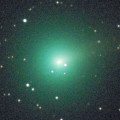
|
Now it is 7.8 mag (Jan. 14, Giuseppe Pappa). It will fade out rapidly after this. It stays observable in good condition.
Date(TT) R.A. (2000) Decl. Delta r Elong. m1 Best Time(A, h)
Jan. 13 12 3.92 11 22.6 0.508 1.284 115 7.3 4:37 ( 0, 66)
Jan. 20 12 18.08 10 40.0 0.503 1.302 118 7.4 4:24 ( 0, 66)
|

|
It returns for the first time in 70 years. It will brighten up to 4.5 mag in spring. It suddenly brightened in major outburst by 5 mag up to 11.5 mag on July 20 (E. Tamas, Francois Kugel). It brightened again in another major outburst up to 9.4 mag on Nov. 15 (Nick James). Now it is 8.6 mag (Jan. 14, Osamu Miyazaki). It will brighten rapidly after this. In the Northern Hemisphere, it will be unobservable in April. In the Southern Hemisphere, it is not observable now, but it will appear in April.
Date(TT) R.A. (2000) Decl. Delta r Elong. m1 Best Time(A, h)
Jan. 13 20 12.77 37 55.6 2.122 1.844 60 8.8 18:38 (122, 22)
Jan. 20 20 36.55 38 5.3 2.044 1.752 58 8.8 18:43 (123, 20)
|

|
Now it is 10.6 mag (Jan. 14, Osamu Miyazaki). It will turn to fade out rapidly after brightening. It stays observable in good condition.
Date(TT) R.A. (2000) Decl. Delta r Elong. m1 Best Time(A, h)
Jan. 13 3 25.12 14 33.9 0.622 1.406 120 9.6 19:57 ( 0, 70)
Jan. 20 3 39.78 14 53.5 0.645 1.400 116 9.1 19:44 ( 0, 70)
|
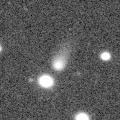
|
Now it is 10.7 mag (Jan. 14, Giuseppe Pappa). It stays 10 mag for a while. In the Northern Hemisphere, it will be getting higher gradually. In the Southern Hemisphere, it stays observable in good condition.
Date(TT) R.A. (2000) Decl. Delta r Elong. m1 Best Time(A, h)
Jan. 13 15 33.81 -34 35.1 1.741 1.407 53 9.8 5:38 (329, 12)
Jan. 20 15 58.66 -32 3.8 1.663 1.375 55 9.6 5:37 (328, 14)
|
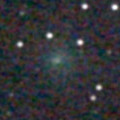
|
Now it is 13.3 mag (Dec. 16, Michael Mattiazzo). It will fade out rapidly after this. It will be fainter than 18 mag in April. In the Northern Hemisphere, it is not observable now, but it will appear in March. In the Southern Hemisphere, it will be unobservable soon. But it will be observable again in February.
Date(TT) R.A. (2000) Decl. Delta r Elong. m1 Best Time(A, h)
Jan. 13 20 50.69 -37 13.4 1.657 0.839 22 11.3 18:38 ( 53,-13)
Jan. 20 20 39.47 -36 36.0 1.709 0.830 17 11.2 18:43 ( 59,-20)
|

|
It approached to Earth down to 0.38 a.u., and brightened up to 8.0 mag in autumn (Sept. 29, Virgilio Gonano). Now it is 12.1 mag (Jan. 13, Osamu Miyazaki). It will fade out rapidly after this. It stays observable in good condition.
Date(TT) R.A. (2000) Decl. Delta r Elong. m1 Best Time(A, h)
Jan. 13 8 32.99 -13 51.2 0.714 1.606 141 12.0 1:07 ( 0, 41)
Jan. 20 8 24.06 -12 46.4 0.756 1.668 146 12.4 0:31 ( 0, 42)
|

|
It was observed at 9-10 mag for a long time in 2023. Now it is 13.0 mag (Jan. 3, Chris Wyatt). Fading slowly. In the Northern Hemisphere, it will be unobservable soon. It locates somewhat low in the Southern Hemisphere. But it will become high in spring.
Date(TT) R.A. (2000) Decl. Delta r Elong. m1 Best Time(A, h)
Jan. 13 23 19.57 -40 40.4 4.068 3.529 50 12.5 18:38 ( 30, 5)
Jan. 20 23 22.02 -40 20.5 4.193 3.584 46 12.7 18:43 ( 35, 2)
|
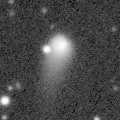
|
Now it is 13.1 mag (Jan. 13, Osamu Miyazaki). It stays 13 mag for a while. In the Northern Hemisphere, it stays observable in good condition.
Date(TT) R.A. (2000) Decl. Delta r Elong. m1 Best Time(A, h)
Jan. 13 8 53.14 15 32.2 3.322 4.262 160 12.7 1:28 ( 0, 70)
Jan. 20 8 42.02 17 11.9 3.258 4.231 170 12.6 0:49 ( 0, 72)
|

|
Now it is 13.7 mag (Dec. 12, Kunihiro Shima). It will fade out rapidly after this. It will be fainter than 18 mag in March. It stays extremely low.
Date(TT) R.A. (2000) Decl. Delta r Elong. m1 Best Time(A, h)
Jan. 13 17 20.05 -17 57.5 1.818 1.111 31 12.8 5:38 (300, 10)
Jan. 20 17 48.73 -16 39.0 1.835 1.135 32 12.9 5:37 (299, 10)
|

|
It brightened up to 8 mag from 2022 summer to 2023 spring. Now it is 12.7 mag (Jan. 3, Chris Wyatt). Fading slowly. It stays observable in good condition.
Date(TT) R.A. (2000) Decl. Delta r Elong. m1 Best Time(A, h)
Jan. 13 5 26.32 -1 12.4 3.913 4.720 141 12.9 21:57 ( 0, 54)
Jan. 20 5 20.92 -0 8.3 4.035 4.781 134 13.0 21:24 ( 0, 55)
|

|
Now it is 13.1 mag (Jan. 13, Osamu Miyazaki). It stays observable in good condition.
Date(TT) R.A. (2000) Decl. Delta r Elong. m1 Best Time(A, h)
Jan. 13 8 29.74 20 57.6 5.206 6.169 167 13.5 1:04 ( 0, 76)
Jan. 20 8 26.28 21 4.7 5.191 6.171 174 13.5 0:33 ( 0, 76)
|

|
Now it is 14.2 mag (Jan. 7, ATLAS Chile). Fading slowly. In the Northern Hemisphere, it will be unobservable in May. In the Southern Hemisphere, it stays observable in good condition.
Date(TT) R.A. (2000) Decl. Delta r Elong. m1 Best Time(A, h)
Jan. 13 9 44.96 -44 4.2 4.039 4.440 107 13.5 2:19 ( 0, 11)
Jan. 20 9 31.57 -44 56.7 4.016 4.475 111 13.6 1:38 ( 0, 10)
|
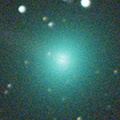
|
It approached to Earth down to 0.2 a.u. in early November, and brightened up to 6.2 mag (Nov. 11, Marco Goiato). Now it is 13.2 mag (Jan. 3, Chris Wyatt). Fading rapidly. In the Northern Hemisphere, it will be unobservable soon. It locates somewhat low in the Southern Hemisphere.
Date(TT) R.A. (2000) Decl. Delta r Elong. m1 Best Time(A, h)
Jan. 13 23 24.20 -42 52.5 1.975 1.570 51 13.6 18:38 ( 28, 4)
Jan. 20 23 32.84 -43 2.4 2.134 1.659 48 14.1 18:43 ( 32, 1)
|
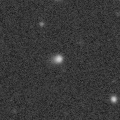
|
It will approach to Sun down to 0.4 a.u. in late September, and it is expected to brighten up to 0 mag. Now it is 13.6 mag (Jan. 11, Toshihiko Ikemura, Hirohisa Sato). It will brighten rapidly after this. In the Northern Hemisphere, it stays observable in good condition. In the Southern Hemisphere, it will be getting higher gradually. At the high light, in the Northern Hemisphere, it will be observable in good condition after the perihelion passage. In the Southern Hemisphere, it will be observable in the low sky before and after the perihelion passage.
Date(TT) R.A. (2000) Decl. Delta r Elong. m1 Best Time(A, h)
Jan. 13 15 5.97 -7 39.4 4.413 4.113 66 13.9 5:38 (320, 39)
Jan. 20 15 8.16 -7 47.4 4.218 4.033 72 13.7 5:37 (327, 41)
|

|
Now it is 14.3 mag (Jan. 14, Giuseppe Pappa). Brightening slowly. It locates somewhat low in the Northern Hemisphere. In the Southern Hemisphere, it will be getting higher gradually. It is expected to brighten up to 12.5 mag in spring. At the high light, it will be observable in excellent condition in the Southern Hemisphere, but it will be low in the Northern Hemisphere.
Date(TT) R.A. (2000) Decl. Delta r Elong. m1 Best Time(A, h)
Jan. 13 15 31.70 -20 8.5 3.183 2.763 56 13.8 5:38 (322, 25)
Jan. 20 15 30.61 -21 38.3 3.042 2.748 63 13.7 5:37 (329, 27)
|

|
It brightened up to 7.8 mag in late July (July 20, Thomas Lehmann). Now it is 14.4 mag (Jan. 14, Giuseppe Pappa). Fading slowly. In the Northern Hemisphere, it stays observable in good condition. In the Southern Hemisphere, it will be getting higher gradually.
Date(TT) R.A. (2000) Decl. Delta r Elong. m1 Best Time(A, h)
Jan. 13 15 14.29 -3 38.3 2.892 2.642 65 14.0 5:38 (315, 41)
Jan. 20 15 11.69 -2 21.0 2.821 2.712 73 14.1 5:37 (323, 46)
|
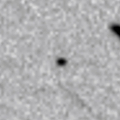
|
It will approach to Earth down to 0.2 a.u. from February to March, and it is expected to brighten up to 13 mag. Now it is 15.6 mag (Jan. 12, ATLAS Chile). It will turn to fade out rapidly after brightening. It will be fainter than 18 mag in May. It stays observable in good condition.
Date(TT) R.A. (2000) Decl. Delta r Elong. m1 Best Time(A, h)
Jan. 13 0 54.50 -14 54.6 0.489 0.982 75 14.4 18:38 ( 22, 37)
Jan. 20 1 14.36 -15 25.5 0.449 0.956 73 14.1 18:43 ( 25, 36)
|

|
It brightened up to 8.3 mag in 2021-2022 winter (Jan. 6, 2022, Toshiyuki Takahashi). Now it is 15.0 mag (Jan. 11, ATLAS Chile). It stays 15 mag for a while. It stays extremely low in the Northern Hemisphere. In the Southern Hemisphere, it stays observable in good condition.
Date(TT) R.A. (2000) Decl. Delta r Elong. m1 Best Time(A, h)
Jan. 13 11 27.27 -50 59.8 7.016 7.107 91 14.3 4:01 ( 0, 4)
Jan. 20 11 25.55 -51 43.9 6.987 7.152 95 14.3 3:32 ( 0, 3)
|

|
Now it is 14.8 mag (Jan. 12, ATLAS Chile). It stays 14 mag for a while. It stays extremely low in the Northern Hemisphere. In the Southern Hemisphere, it stays observable in good condition.
Date(TT) R.A. (2000) Decl. Delta r Elong. m1 Best Time(A, h)
Jan. 13 12 11.88 -37 53.9 5.188 5.312 91 14.3 4:45 ( 0, 17)
Jan. 20 12 13.53 -38 16.5 5.077 5.294 97 14.3 4:19 ( 0, 17)
|
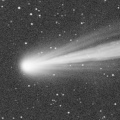
|
It approached to Sun down to 0.23 a.u. and brightened up to 2.5 mag in mid September (Sept. 18, Juan Jose Gonzalez). Now it is 11.8 mag (Dec. 16, Martin Masek). It will fade out rapidly after this. In the Northern Hemisphere, it is not observable now, but it will appear in February. In the Southern Hemisphere, it stays observable in good condition. It is brighter than this ephemeris recently.
Date(TT) R.A. (2000) Decl. Delta r Elong. m1 Best Time(A, h)
Jan. 13 11 36.04 -55 43.8 2.256 2.420 87 14.6 4:10 ( 0, -1)
Jan. 20 11 13.02 -56 53.3 2.266 2.522 93 14.8 3:20 ( 0, -2)
|
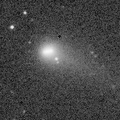
|
Now it is 14.2 mag (Jan. 9, Toshihiko Ikemura, Hirohisa Sato). It stays 15 mag for a while. In the Northern Hemisphere, it stays observable in good condition. It locates somewhat low in the Southern Hemisphere.
Date(TT) R.A. (2000) Decl. Delta r Elong. m1 Best Time(A, h)
Jan. 13 2 46.09 19 39.5 1.622 2.202 113 14.7 19:18 ( 0, 75)
Jan. 20 2 50.44 20 23.8 1.675 2.179 107 14.7 18:54 ( 0, 76)
|

|
It brightened up to 12.1 mag in 2023 spring (May 20, Jose Guilherme de S. Aguiar). Now it is 15.0 mag (Jan. 11, ATLAS Chile). Fading slowly. In the Northern Hemisphere, it is not observable now. In the Southern Hemisphere, it stays observable in good condition.
Date(TT) R.A. (2000) Decl. Delta r Elong. m1 Best Time(A, h)
Jan. 13 3 50.10 -79 26.9 4.038 3.892 74 14.9 20:18 ( 0,-24)
Jan. 20 3 45.84 -77 3.9 4.060 3.932 75 14.9 19:47 ( 0,-22)
|

|
It returned for the first time in 68 years. It will brighten up to 7.5 mag in summer. Now it is 15.3 mag (Jan. 14, Toshihiko Ikemura, Hirohisa Sato). It will brighten rapidly after this. In the Northern Hemisphere, it stays observable in good condition. In the Southern Hemisphere, it will be getting lower gradually after this, and it will be unobservable in May. At the high light, it locates low in the Northern Hemisphere, or it is not observable in the Southern Hemisphere.
Date(TT) R.A. (2000) Decl. Delta r Elong. m1 Best Time(A, h)
Jan. 13 2 55.57 -11 58.5 2.179 2.595 103 15.3 19:26 ( 0, 43)
Jan. 20 2 52.98 -9 50.1 2.194 2.521 97 15.0 18:56 ( 0, 45)
|

|
First return of a new periodic comet which brightened up to 10 mag in 2001. It is expected to brighten up to 12-13 mag from February to March. Now it is 16.4 mag (Jan. 11, Toshihiko Ikemura, Hirohisa Sato). It will brighten rapidly after this. In the Northern Hemisphere, it will be getting lower gradually. But it will be getting higher again after April. In the Southern Hemisphere, it will be unobservable soon. Thomas Lehmann reported it was bright as 14.2 mag on Dec. 30.
Date(TT) R.A. (2000) Decl. Delta r Elong. m1 Best Time(A, h)
Jan. 13 23 22.03 3 24.9 1.732 1.520 60 16.2 18:38 ( 60, 41)
Jan. 20 23 28.35 7 29.5 1.769 1.488 57 15.2 18:43 ( 70, 39)
|
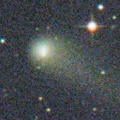
|
It brightened up to 11.1 mag in early 2022 (Mar. 31, 2022, F. Kugel, J.-G. Bosch, J. Nicolas). Now it is 15.1 mag (Jan. 4, Ken-ichi Kadota). It stays 16 mag for a while. In the Northern Hemisphere, it stays observable in good condition. In the Southern Hemisphere, it is not observable now, but it will appear in February.
Date(TT) R.A. (2000) Decl. Delta r Elong. m1 Best Time(A, h)
Jan. 13 17 10.88 17 37.2 6.848 6.302 52 15.3 5:38 (271, 33)
Jan. 20 17 16.04 18 9.8 6.830 6.340 56 15.4 5:37 (274, 38)
|

|
Now it is 14.8 mag (Jan. 1, Ken-ichi Kadota). It will fade out rapidly after this. It will be fainter than 18 mag in April. In the Northern Hemisphere, it stays observable in good condition. In the Southern Hemisphere, it will be getting lower gradually after this, and it will be unobservable in March. It is brighter than this ephemeris recently.
Date(TT) R.A. (2000) Decl. Delta r Elong. m1 Best Time(A, h)
Jan. 13 1 0.58 -1 57.0 1.640 1.781 81 15.5 18:38 ( 26, 50)
Jan. 20 1 8.42 2 0.4 1.721 1.788 77 15.7 18:43 ( 38, 51)
|

|
Now it is 15.6 mag (Jan. 11, Toshihiko Ikemura, Hirohisa Sato). It stays 16 mag for a while. In the Northern Hemisphere, it will be getting lower gradually after this, and it will be unobservable in May. In the Southern Hemisphere, it stays observable in good condition.
Date(TT) R.A. (2000) Decl. Delta r Elong. m1 Best Time(A, h)
Jan. 13 4 31.31 -10 52.6 6.400 7.003 124 15.9 21:02 ( 0, 44)
Jan. 20 4 29.94 -10 19.2 6.444 6.973 118 15.9 20:33 ( 0, 45)
|
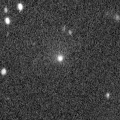
|
Very large comet. It is expected to brighten up to 13 mag in 2031. Now it is 15.9 mag (Jan. 1, Thomas Lehmann). It stays 16 mag for a while. In the Northern Hemisphere, it is not observable now. In the Southern Hemisphere, it stays observable in good condition. In the Northern Hemisphere, it is not observable until 2030.
Date(TT) R.A. (2000) Decl. Delta r Elong. m1 Best Time(A, h)
Jan. 13 2 52.82 -65 0.3 16.980 16.807 78 15.9 19:23 ( 0,-10)
Jan. 20 2 52.13 -64 43.3 16.984 16.783 76 15.9 18:55 ( 0,-10)
|

|
It brightened up to 14 mag in early 2023 and 2023 autumn. Now it is 16.5 mag (Jan. 1, ATLAS-MLO, Mauna Loa). It stays 16 mag for a while. In the Northern Hemisphere, it will be getting lower gradually after this, and it will be unobservable in February. But it will be observable again in March. In the Southern Hemisphere, it is not observable now, but it will appear in April.
Date(TT) R.A. (2000) Decl. Delta r Elong. m1 Best Time(A, h)
Jan. 13 22 30.54 4 24.5 4.449 3.895 50 15.9 18:38 ( 71, 32)
Jan. 20 22 31.36 4 51.4 4.580 3.930 43 16.0 18:43 ( 77, 26)
|

|
Now it is 16.6 mag (Jan. 5, ATLAS Chile). It stays 16 mag for a while. In the Northern Hemisphere, it will be unobservable in March. In the Southern Hemisphere, it will be getting lower gradually. The brightness evolution is slower than originally expected.
Date(TT) R.A. (2000) Decl. Delta r Elong. m1 Best Time(A, h)
Jan. 13 1 41.30 -30 23.5 3.374 3.356 80 16.1 18:38 ( 6, 24)
Jan. 20 1 40.21 -30 32.4 3.438 3.317 74 16.1 18:43 ( 14, 23)
|
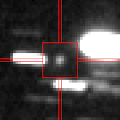
|
It is expected to brighten up to 12.5 mag in summer. Now it is 17.1 mag (Dec. 20, E. Cortes). Brightening gradually. In the Northern Hemisphere, it is not observable now. In the Southern Hemisphere, it stays observable in good condition. Around the high light, it is observable in good condition in the Southern Hemisphere, but it locates very low in the Northern Hemisphere.
Date(TT) R.A. (2000) Decl. Delta r Elong. m1 Best Time(A, h)
Jan. 13 14 36.82 -61 11.9 4.360 4.022 63 16.2 5:38 (349, -8)
Jan. 20 14 49.44 -62 27.7 4.249 3.968 66 16.1 5:37 (351, -9)
|

|
Now it is 16.0 mag (Jan. 5, Ken-ichi Kadota). Fading gradually. It will be fainter than 18 mag in April. In the Northern Hemisphere, it will be getting lower gradually. In the Southern Hemisphere, it will be unobservable in March.
Date(TT) R.A. (2000) Decl. Delta r Elong. m1 Best Time(A, h)
Jan. 13 0 0.94 4 53.2 2.256 2.135 70 16.1 18:38 ( 51, 49)
Jan. 20 0 14.36 6 8.1 2.331 2.143 66 16.3 18:43 ( 58, 46)
|

|
It brightened up to 13 mag in early 2023. It stays 16 mag for a while. In the Northern Hemisphere, it is not observable now, but it will be observable soon. In the Southern Hemisphere, it stays observable in good condition.
Date(TT) R.A. (2000) Decl. Delta r Elong. m1 Best Time(A, h)
Jan. 13 16 7.51 -48 17.5 4.121 3.553 48 16.3 5:38 (332, -3)
Jan. 20 16 14.77 -48 13.4 4.109 3.612 53 16.4 5:37 (334, -1)
|
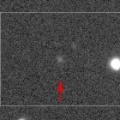
|
It will be observable at 15-16 mag from 2024 to 2025. Now it is 17.6 mag (Jan. 11, Toshihiko Ikemura, Hirohisa Sato). It stays 16 mag for a while. It stays observable in good condition.
Date(TT) R.A. (2000) Decl. Delta r Elong. m1 Best Time(A, h)
Jan. 13 13 12.01 1 40.1 3.507 3.738 95 16.5 5:38 (357, 57)
Jan. 20 13 15.01 1 33.6 3.388 3.723 102 16.4 5:21 ( 0, 56)
|
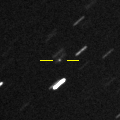
|
Now it is 16.3 mag (Jan. 9, Toshihiko Ikemura, Hirohisa Sato). Fading slowly. It stays observable in good condition.
Date(TT) R.A. (2000) Decl. Delta r Elong. m1 Best Time(A, h)
Jan. 13 9 10.38 -5 32.3 0.951 1.840 144 16.7 1:44 ( 0, 49)
Jan. 20 9 6.61 -7 56.7 0.911 1.821 147 16.5 1:13 ( 0, 47)
|
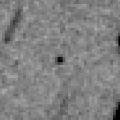
|
Now it is 15.8 mag (Jan. 14, Toshihiko Ikemura, Hirohisa Sato). Fading slowly. It will be fainter than 18 mag in May. In the Northern Hemisphere, it stays observable in good condition. It locates somewhat low in the Southern Hemisphere.
Date(TT) R.A. (2000) Decl. Delta r Elong. m1 Best Time(A, h)
Jan. 13 7 35.65 38 37.3 0.745 1.710 163 16.7 0:11 (180, 86)
Jan. 20 7 31.39 39 9.2 0.732 1.690 159 16.6 23:34 (180, 86)
|
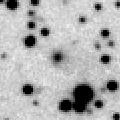
|
Now it is 16.7 mag (Jan. 8, ATLAS-MLO, Mauna Loa). It stays 17 mag for a while. In the Northern Hemisphere, it stays observable in good condition. In the Southern Hemisphere, it will be unobservable in April.
Date(TT) R.A. (2000) Decl. Delta r Elong. m1 Best Time(A, h)
Jan. 13 4 33.42 41 7.9 5.934 6.690 137 16.7 21:05 (180, 84)
Jan. 20 4 32.28 40 54.8 6.007 6.690 130 16.7 20:36 (180, 84)
|

|
Now it is 17.0 mag (Jan. 9, Toshihiko Ikemura, Hirohisa Sato). It stays 17 mag for a while. In the Northern Hemisphere, it stays observable in good condition. It locates somewhat low in the Southern Hemisphere. But it will become high in autumn.
Date(TT) R.A. (2000) Decl. Delta r Elong. m1 Best Time(A, h)
Jan. 13 4 35.88 32 34.7 4.283 5.067 139 16.7 21:07 ( 0, 88)
Jan. 20 4 34.59 31 49.8 4.340 5.050 131 16.7 20:38 ( 0, 87)
|
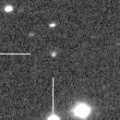
|
Now it is 16.5 mag (Jan. 9, Toshihiko Ikemura, Hirohisa Sato). It stays 16 mag for a while. It locates somewhat low in the Northern Hemisphere. But it will become high in summer. In the Southern Hemisphere, it stays observable in good condition.
Date(TT) R.A. (2000) Decl. Delta r Elong. m1 Best Time(A, h)
Jan. 13 13 38.71 -26 29.5 3.498 3.460 79 16.8 5:38 (351, 28)
Jan. 20 13 45.70 -27 5.1 3.400 3.455 84 16.7 5:37 (356, 28)
|

|
It is expected to brighten up to 13 mag in early summer. Now it is 16.4 mag (Jan. 11, Toshihiko Ikemura, Hirohisa Sato). It will brighten rapidly after this. It locates somewhat low in the Northern Hemisphere. In the Southern Hemisphere, it will be getting lower gradually after this, and it will be unobservable in April. At the high light, it is not observable in the Southern Hemisphere, or it locates low in the Northern Hemisphere.
Date(TT) R.A. (2000) Decl. Delta r Elong. m1 Best Time(A, h)
Jan. 13 2 4.71 -30 45.5 2.206 2.338 85 16.9 18:38 ( 0, 25)
Jan. 20 2 2.12 -27 14.9 2.205 2.258 80 16.8 18:43 ( 10, 27)
|
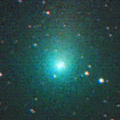
|
It brightened up to 9.5 mag from last winter to early spring (Jan. 30, Katsumi Yoshimoto). Now it is 16.9 mag (Jan. 5, ATLAS-MLO, Mauna Loa). Fading slowly. It will be fainter than 18 mag in March. It will be unobservable in February.
Date(TT) R.A. (2000) Decl. Delta r Elong. m1 Best Time(A, h)
Jan. 13 22 53.01 -14 30.7 4.791 4.189 47 16.8 18:38 ( 52, 23)
Jan. 20 22 57.39 -14 35.5 4.940 4.253 41 17.0 18:43 ( 57, 18)
|
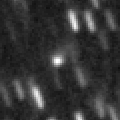
|
It stays 16 mag in the Southern sky for a long time from 2024 to 2025. Brightening slowly. In the Northern Hemisphere, it is not observable now, but it will be observable soon. In the Southern Hemisphere, it will be getting higher gradually.
Date(TT) R.A. (2000) Decl. Delta r Elong. m1 Best Time(A, h)
Jan. 13 16 51.90 -42 55.5 6.662 5.941 39 16.9 5:38 (322, -4)
Jan. 20 16 53.51 -43 27.2 6.559 5.917 45 16.8 5:37 (326, -1)
|
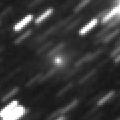
|
Very far object. Now it is 16.8 mag (Jan. 7, ATLAS Chile). It stays 17 mag for a while. In the Northern Hemisphere, it is not observable now. In the Southern Hemisphere, it stays observable in good condition.
Date(TT) R.A. (2000) Decl. Delta r Elong. m1 Best Time(A, h)
Jan. 13 2 23.87 -73 25.8 10.567 10.318 72 16.8 18:54 ( 0,-18)
Jan. 20 2 19.00 -72 36.2 10.586 10.319 71 16.8 18:43 ( 2,-18)
|
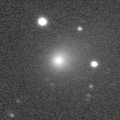
|
It continued brightening even after the perihelion passage, and it brightened up to 13.1 mag in autumn (Sept. 12, Taras Prystavski). Now it is 16.3 mag (Jan. 6, Yukihiro Sugiyama). It will fade out rapidly after this. It will be fainter than 18 mag in February. In the Northern Hemisphere, it will be getting lower gradually. It locates somewhat low in the Southern Hemisphere.
Date(TT) R.A. (2000) Decl. Delta r Elong. m1 Best Time(A, h)
Jan. 13 0 11.23 -11 29.0 3.981 3.701 66 16.9 18:38 ( 36, 36)
Jan. 20 0 17.65 -10 17.5 4.115 3.745 61 17.1 18:43 ( 43, 34)
|
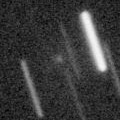
|
It brightened up to 14.7 mag at the discovery in December (Dec. 6, Hidetaka Sato). Now it is 18.7 mag (Jan. 8, D. Buczynski). Fading rapidly. It will be fainter than 18 mag in February. In the Northern Hemisphere, it stays observable in good condition. In the Southern Hemisphere, it will never be observable after this.
Date(TT) R.A. (2000) Decl. Delta r Elong. m1 Best Time(A, h)
Jan. 13 15 14.15 73 38.3 1.188 1.718 104 16.9 5:38 (193, 48)
Jan. 20 16 48.51 79 29.2 1.304 1.805 103 17.4 5:37 (191, 42)
|

|
First return of a new periodic comet which was discovered in 2011, half a year after the perihelion passage. It is expected to brighten up to 14.5 mag in spring. Maik Meyer pointed out the identification of Asteroid 2023 WM26 and this comet. Now it is 18.8 mag (Jan. 5, Toshihiko Ikemura, Hirohisa Sato). Brightening gradually. It stays observable in good condition.
Date(TT) R.A. (2000) Decl. Delta r Elong. m1 Best Time(A, h)
Jan. 13 8 43.29 15 33.7 0.960 1.922 162 17.2 1:18 ( 0, 71)
Jan. 20 8 36.18 14 13.5 0.883 1.860 170 16.9 0:43 ( 0, 69)
|
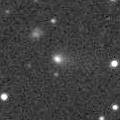
|
Now it is 16.6 mag (Jan. 4, Ken-ichi Kadota). Fading slowly. It will be fainter than 18 mag in March. In the Northern Hemisphere, it stays observable in good condition. In the Southern Hemisphere, it will be getting lower gradually.
Date(TT) R.A. (2000) Decl. Delta r Elong. m1 Best Time(A, h)
Jan. 13 3 17.69 5 49.6 2.706 3.260 116 17.0 19:49 ( 0, 61)
Jan. 20 3 19.20 6 23.9 2.811 3.276 109 17.1 19:23 ( 0, 62)
|
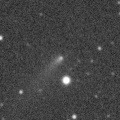
|
It brightened very rapidly up to 14.9 mag in early summer (July 13, Taras Prystavski). Now it is 17.5 mag (Jan. 9, Toshihiko Ikemura, Hirohisa Sato). Fading slowly. It will be fainter than 18 mag in April. In the Northern Hemisphere, it stays observable in good condition. In the Southern Hemisphere, it will be getting higher gradually.
Date(TT) R.A. (2000) Decl. Delta r Elong. m1 Best Time(A, h)
Jan. 13 15 4.66 1 36.2 2.696 2.531 69 17.0 5:38 (314, 46)
Jan. 20 15 3.88 4 6.2 2.603 2.579 77 17.0 5:37 (320, 52)
|

|
New peridic comet which brightened up to 16 mag in 2007. It has not been recovered yet. It was missed in 2013 and 2018. It will approach to Earth down to 0.34 a.u. in winter, and it is expected to brighten up to 16 mag. It will fade out rapidly after this. It will be fainter than 18 mag soon. In the Northern Hemisphere, it stays observable in good condition. It stays extremely low in the Southern Hemisphere.
Date(TT) R.A. (2000) Decl. Delta r Elong. m1 Best Time(A, h)
Jan. 13 1 41.50 40 4.6 0.431 1.171 104 17.0 18:38 (144, 83)
Jan. 20 2 42.85 41 23.6 0.516 1.259 110 17.6 18:50 (180, 83)
|
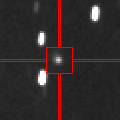
|
Now it is 17.1 mag (Jan. 11, ATLAS Chile). It stays 17 mag for a while. In the Northern Hemisphere, it will be unobservable in April. In the Southern Hemisphere, it stays observable in good condition.
Date(TT) R.A. (2000) Decl. Delta r Elong. m1 Best Time(A, h)
Jan. 13 4 48.89 -39 26.3 7.294 7.650 107 17.1 21:19 ( 0, 16)
Jan. 20 4 47.39 -38 49.4 7.313 7.626 104 17.1 20:50 ( 0, 16)
|
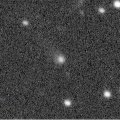
|
Now it is 16.9 mag (Jan. 3, W68 ATLAS Chile). It stays 18 mag for a while. In the Northern Hemisphere, it will never be observable after this. In the Southern Hemisphere, it stays observable in good condition.
Date(TT) R.A. (2000) Decl. Delta r Elong. m1 Best Time(A, h)
Jan. 13 7 41.00 -71 47.6 3.753 3.822 86 17.1 0:15 ( 0,-17)
Jan. 20 7 6.95 -72 34.1 3.769 3.838 86 17.1 23:05 ( 0,-18)
|

|
It approached to Earth down to 0.29 a.u. in early last February, and it brightened up to 4.5 mag (Feb. 1, Juan Jose Gonzalez). Now it is 18.2 mag (Dec. 28, Jean-Claude Merlin). Fading slowly. It will be fainter than 18 mag in March. In the Northern Hemisphere, it will never be observable after this. In the Southern Hemisphere, it stays observable in good condition.
Date(TT) R.A. (2000) Decl. Delta r Elong. m1 Best Time(A, h)
Jan. 13 3 17.13 -59 10.8 4.765 4.757 83 17.2 19:47 ( 0, -4)
Jan. 20 3 10.48 -58 1.5 4.879 4.825 81 17.3 19:13 ( 0, -3)
|
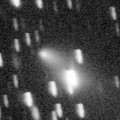
|
It brightened up to 13.6 mag in summer (July 16, Mitsunori Tsumura). Now it is 17.1 mag (Dec. 31, ATLAS-MLO, Mauna Loa). Fading gradually. It will be fainter than 18 mag in February. In the Northern Hemisphere, it stays observable in good condition. In the Southern Hemisphere, it will never be observable after this.
Date(TT) R.A. (2000) Decl. Delta r Elong. m1 Best Time(A, h)
Jan. 13 0 9.21 63 19.3 2.246 2.607 100 17.2 18:38 (157, 56)
Jan. 20 0 24.54 63 5.6 2.342 2.656 97 17.4 18:43 (154, 55)
|
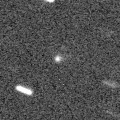
|
Now it is 17.3 mag (Jan. 11, Toshihiko Ikemura, Hirohisa Sato). It stays 17 mag for a while. It will be getting lower gradually after this, and it will be unobservable in May.
Date(TT) R.A. (2000) Decl. Delta r Elong. m1 Best Time(A, h)
Jan. 13 1 30.88 0 33.9 2.404 2.586 89 17.3 18:38 ( 15, 55)
Jan. 20 1 35.98 1 29.2 2.461 2.549 83 17.2 18:43 ( 27, 54)
|
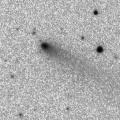
|
Now it is 16.3 mag (Jan. 6, Yukihiro Sugiyama). It stays 18 mag for a while. In the Northern Hemisphere, it will be getting lower gradually. In the Southern Hemisphere, it will be unobservable in March. It is brighter than this ephemeris recently.
Date(TT) R.A. (2000) Decl. Delta r Elong. m1 Best Time(A, h)
Jan. 13 0 22.68 -3 31.2 4.105 3.913 71 17.3 18:38 ( 38, 45)
Jan. 20 0 27.64 -2 44.4 4.220 3.929 66 17.4 18:43 ( 46, 41)
|

|
It brightened up to 14.1 mag in 2022 spring (Mar. 22, 2022, Chris Wyatt). Now it is 16.9 mag (Jan. 5, ATLAS-HKO, Haleakala). It stays 18 mag for a while. In the Northern Hemisphere, it will be getting lower gradually. In the Southern Hemisphere, it will be getting lower gradually after this, and it will be unobservable in March.
Date(TT) R.A. (2000) Decl. Delta r Elong. m1 Best Time(A, h)
Jan. 13 1 16.51 1 39.4 6.010 6.028 86 17.3 18:38 ( 22, 55)
Jan. 20 1 16.12 2 14.1 6.180 6.076 79 17.4 18:43 ( 35, 52)
|
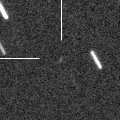
|
Now it is 17.2 mag (Jan. 11, Toshihiko Ikemura, Hirohisa Sato). Fading gradually. It will be fainter than 18 mag in March. It locates somewhat low in the Northern Hemisphere. In the Southern Hemisphere, it stays observable in good condition.
Date(TT) R.A. (2000) Decl. Delta r Elong. m1 Best Time(A, h)
Jan. 13 10 51.23 -23 38.2 1.633 2.225 114 17.3 3:26 ( 0, 31)
Jan. 20 10 29.32 -27 24.8 1.588 2.256 120 17.3 2:36 ( 0, 28)
|

|
Now it is 17.5 mag (Jan. 4, ATLAS-MLO, Mauna Loa). Fading gradually. It will be fainter than 18 mag in February. In the Northern Hemisphere, it stays observable in good condition. In the Southern Hemisphere, it will never be observable after this.
Date(TT) R.A. (2000) Decl. Delta r Elong. m1 Best Time(A, h)
Jan. 13 0 45.66 75 48.2 1.477 2.012 108 17.4 18:38 (173, 48)
Jan. 20 1 44.22 74 15.7 1.489 2.024 108 17.4 18:43 (175, 50)
|

|
Now it is 17.7 mag (Jan. 9, Toshihiko Ikemura, Hirohisa Sato). It stays 18 mag for a while. In the Northern Hemisphere, it will be getting lower gradually. But it will be getting higher again after March. In the Southern Hemisphere, it is not observable now, but it will appear in April.
Date(TT) R.A. (2000) Decl. Delta r Elong. m1 Best Time(A, h)
Jan. 13 22 33.05 39 22.2 4.413 4.246 73 17.5 18:38 (112, 48)
Jan. 20 22 33.51 38 34.6 4.500 4.238 68 17.5 18:43 (114, 41)
|
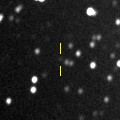
|
Now it is 16.9 mag (Jan. 11, Toshihiko Ikemura, Hirohisa Sato). It stays 17 mag for a while. It stays observable in good condition.
Date(TT) R.A. (2000) Decl. Delta r Elong. m1 Best Time(A, h)
Jan. 13 8 5.80 -9 10.0 4.008 4.872 148 17.6 0:40 ( 0, 46)
Jan. 20 8 2.29 -9 23.6 3.953 4.832 150 17.5 0:09 ( 0, 46)
|
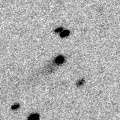
|
Now it is 17.4 mag (Jan. 11, ATLAS-MLO, Mauna Loa). It stays 18 mag for a while. It stays observable in good condition.
Date(TT) R.A. (2000) Decl. Delta r Elong. m1 Best Time(A, h)
Jan. 13 12 28.39 15 6.3 8.974 9.366 110 17.6 5:02 ( 0, 70)
Jan. 20 12 26.20 15 36.3 8.877 9.380 118 17.5 4:32 ( 0, 70)
|

|
Now it is 17.4 mag (Jan. 10, ATLAS Chile). Fading slowly. It will be fainter than 18 mag in March. It stays observable in good condition.
Date(TT) R.A. (2000) Decl. Delta r Elong. m1 Best Time(A, h)
Jan. 13 12 6.87 5 10.4 1.550 2.128 112 17.7 4:40 ( 0, 60)
Jan. 20 12 11.41 4 21.3 1.482 2.130 118 17.6 4:17 ( 0, 59)
|
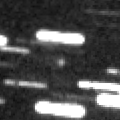
|
Now it is 18.6 mag (Jan. 11, Yasukazu Ikari). It stays 18 mag for a while. It stays observable in good condition.
Date(TT) R.A. (2000) Decl. Delta r Elong. m1 Best Time(A, h)
Jan. 13 6 44.26 9 9.2 6.820 7.764 162 17.7 23:14 ( 0, 64)
Jan. 20 6 38.27 9 10.1 6.855 7.766 156 17.7 22:41 ( 0, 64)
|
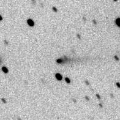
|
Now it is 17.6 mag (Jan. 9, Toshihiko Ikemura, Hirohisa Sato). Fading slowly. It will be fainter than 18 mag in February. It stays observable in good condition.
Date(TT) R.A. (2000) Decl. Delta r Elong. m1 Best Time(A, h)
Jan. 13 8 42.52 -4 31.0 3.179 4.054 149 17.7 1:17 ( 0, 50)
Jan. 20 8 38.58 -4 15.5 3.161 4.068 154 17.8 0:45 ( 0, 51)
|

|
It is expected to brighten up to 15.5 mag from March to April. Now it is 18.7 mag (Dec. 10, Kitt Peak-Bok). Brightening gradually. It locates somewhat low in the Northern Hemisphere. But it will become high in spring. In the Southern Hemisphere, it will be getting higher gradually.
Date(TT) R.A. (2000) Decl. Delta r Elong. m1 Best Time(A, h)
Jan. 13 15 43.64 -12 56.9 1.956 1.618 55 18.1 5:38 (315, 29)
Jan. 20 16 5.24 -13 35.8 1.895 1.597 57 17.7 5:37 (316, 29)
|

|
Now it is 18.7 mag (Jan. 8, ATLAS Chile). Brightening slowly. It locates somewhat low in the Northern Hemisphere. In the Southern Hemisphere, it stays observable in good condition. Giuseppe Pappa reported it was bright as 16 mag on Dec. 27.
Date(TT) R.A. (2000) Decl. Delta r Elong. m1 Best Time(A, h)
Jan. 13 15 1.78 -25 28.4 3.546 3.204 62 17.8 5:38 (331, 23)
Jan. 20 15 10.58 -26 7.4 3.452 3.198 66 17.8 5:37 (336, 24)
|
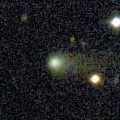
|
It brightened up to 13.9 mag in early 2023 (Jan. 21, Hidenori Nohara). Now it is 19.1 mag (Jan. 11, Toshihiko Ikemura, Hirohisa Sato). It stays 18 mag for a while. In the Northern Hemisphere, it stays observable in good condition. In the Southern Hemisphere, it will be getting higher gradually.
Date(TT) R.A. (2000) Decl. Delta r Elong. m1 Best Time(A, h)
Jan. 13 14 29.21 6 29.0 4.630 4.561 79 17.8 5:38 (321, 55)
Jan. 20 14 33.42 6 38.6 4.571 4.602 85 17.8 5:37 (330, 58)
|
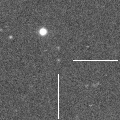
|
Far asteroid moving along a cometary orbit. It brightens up to 18 mag from 2024 to 2025. It stays 18 mag for a while. In the Northern Hemisphere, it stays observable in good condition. It stays extremely low in the Southern Hemisphere.
Date(TT) R.A. (2000) Decl. Delta r Elong. m1 Best Time(A, h)
Jan. 13 8 45.91 50 53.5 7.943 8.790 147 17.9 1:21 (180, 74)
Jan. 20 8 38.42 50 58.5 7.930 8.786 148 17.8 0:46 (180, 74)
|
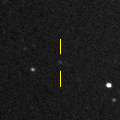
|
Now it is 17.6 mag (Jan. 5, Toshihiko Ikemura, Hirohisa Sato). It stays 18 mag for a while. It stays observable in good condition.
Date(TT) R.A. (2000) Decl. Delta r Elong. m1 Best Time(A, h)
Jan. 13 11 6.90 -0 20.4 5.469 6.072 123 17.9 3:41 ( 0, 55)
Jan. 20 11 4.62 0 27.6 5.335 6.035 131 17.8 3:11 ( 0, 55)
|
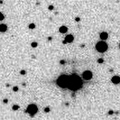
|
Now it is 18.9 mag (Jan. 5, Toshihiko Ikemura, Hirohisa Sato). It stays 18 mag for a while. It stays observable in good condition.
Date(TT) R.A. (2000) Decl. Delta r Elong. m1 Best Time(A, h)
Jan. 13 10 15.32 12 22.5 3.420 4.227 140 17.9 2:49 ( 0, 67)
Jan. 20 10 12.75 12 36.2 3.366 4.236 148 17.9 2:19 ( 0, 67)
|
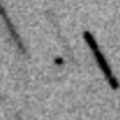
|
Now it is 18.0 mag (Jan. 14, Toshihiko Ikemura, Hirohisa Sato). Brightening gradually. In the Northern Hemisphere, it will be getting lower gradually after this, and it will be unobservable in April. In the Southern Hemisphere, it will be getting lower gradually. It will brighten up to 11 mag in summer. But it is not observable at the high light.
Date(TT) R.A. (2000) Decl. Delta r Elong. m1 Best Time(A, h)
Jan. 13 2 10.75 -9 21.8 3.015 3.248 94 18.0 18:42 ( 0, 46)
Jan. 20 2 11.18 -8 57.9 3.039 3.168 88 17.9 18:43 ( 10, 46)
|

|
It brightened up to 13.4 mag in 2022 summer (July 7, 2022, Giuseppe Pappa). Now it is 18.4 mag (Jan. 2, G. Muler). It stays 18 mag for a while. In the Northern Hemisphere, it stays observable in good condition. In the Southern Hemisphere, it will never be observable after this.
Date(TT) R.A. (2000) Decl. Delta r Elong. m1 Best Time(A, h)
Jan. 13 16 23.84 36 0.2 5.595 5.394 73 17.9 5:38 (254, 50)
Jan. 20 16 26.59 37 16.5 5.577 5.443 77 18.0 5:37 (253, 55)
|
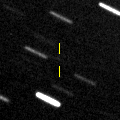
|
Now it is 18.2 mag (Jan. 8, Toshihiko Ikemura, Hirohisa Sato). Fading gradually. It locates somewhat low in the Northern Hemisphere. It stays extremely low in the Southern Hemisphere.
Date(TT) R.A. (2000) Decl. Delta r Elong. m1 Best Time(A, h)
Jan. 13 23 19.68 -10 0.9 2.125 1.757 55 18.4 18:38 ( 49, 31)
Jan. 20 23 35.92 -7 48.9 2.180 1.762 52 18.5 18:43 ( 55, 29)
|
|
![]()
 C/2017 K2 ( PanSTARRS )
C/2017 K2 ( PanSTARRS ) 29P/Schwassmann-Wachmann 1
29P/Schwassmann-Wachmann 1 C/2019 U5 ( PanSTARRS )
C/2019 U5 ( PanSTARRS ) C/2023 H2 ( Lemmon )
C/2023 H2 ( Lemmon ) C/2023 A3 ( Tsuchinshan-ATLAS )
C/2023 A3 ( Tsuchinshan-ATLAS ) C/2022 L2 ( ATLAS )
C/2022 L2 ( ATLAS ) C/2021 T4 ( Lemmon )
C/2021 T4 ( Lemmon ) 207P/NEAT
207P/NEAT C/2019 L3 ( ATLAS )
C/2019 L3 ( ATLAS ) C/2021 G2 ( ATLAS )
C/2021 G2 ( ATLAS ) C/2023 P1 ( Nishimura )
C/2023 P1 ( Nishimura ) 32P/Comas Sola
32P/Comas Sola C/2020 K1 ( PanSTARRS )
C/2020 K1 ( PanSTARRS ) 13P/Olbers
13P/Olbers P/2023 W1 ( NEAT )
P/2023 W1 ( NEAT ) C/2019 T4 ( ATLAS )
C/2019 T4 ( ATLAS ) 226P/Pigott-LINEAR-Kowalski
226P/Pigott-LINEAR-Kowalski C/2022 QE78 ( ATLAS )
C/2022 QE78 ( ATLAS ) C/2014 UN271 ( Bernardinelli-Bernstein )
C/2014 UN271 ( Bernardinelli-Bernstein ) C/2021 X1 ( Maury-Attard )
C/2021 X1 ( Maury-Attard ) C/2022 S4 ( Lemmon )
C/2022 S4 ( Lemmon ) C/2023 C2 ( ATLAS )
C/2023 C2 ( ATLAS ) 471P/2023 KF3
471P/2023 KF3 C/2021 Y1 ( ATLAS )
C/2021 Y1 ( ATLAS ) 65P/Gunn
65P/Gunn 150P/LONEOS
150P/LONEOS 227P/Catalina-LINEAR
227P/Catalina-LINEAR C/2021 S4 ( Tsuchinshan )
C/2021 S4 ( Tsuchinshan ) C/2022 U3 ( Bok )
C/2022 U3 ( Bok ) C/2022 T1 ( Lemmon )
C/2022 T1 ( Lemmon ) C/2023 V4 ( Camarasa-Duszanowicz )
C/2023 V4 ( Camarasa-Duszanowicz ) C/2022 A2 ( PanSTARRS )
C/2022 A2 ( PanSTARRS ) C/2023 F3 ( ATLAS )
C/2023 F3 ( ATLAS ) C/2019 E3 ( ATLAS )
C/2019 E3 ( ATLAS ) C/2022 JK5 ( PanSTARRS )
C/2022 JK5 ( PanSTARRS ) C/2023 X1 ( Leonard )
C/2023 X1 ( Leonard ) P/2011 NO1 ( Elenin )
P/2011 NO1 ( Elenin ) 170P/Christensen
170P/Christensen C/2023 K1 ( ATLAS )
C/2023 K1 ( ATLAS ) P/2007 T2 ( Kowalski )
P/2007 T2 ( Kowalski ) C/2022 R6 ( PanSTARRS )
C/2022 R6 ( PanSTARRS ) C/2022 A3 ( Lemmon-ATLAS )
C/2022 A3 ( Lemmon-ATLAS ) C/2022 E3 ( ZTF )
C/2022 E3 ( ZTF ) 126P/IRAS
126P/IRAS 30P/Reinmuth 1
30P/Reinmuth 1 117P/Helin-Roman-Alu 1
117P/Helin-Roman-Alu 1 C/2020 Y2 ( ATLAS )
C/2020 Y2 ( ATLAS ) C/2022 V2 ( Lemmon )
C/2022 V2 ( Lemmon ) C/2023 T2 ( Borisov )
C/2023 T2 ( Borisov ) C/2022 U1 ( Leonard )
C/2022 U1 ( Leonard ) C/2023 T3 ( Fuls )
C/2023 T3 ( Fuls ) C/2020 F2 ( ATLAS )
C/2020 F2 ( ATLAS ) 216P/LINEAR
216P/LINEAR C/2021 A9 ( PanSTARRS )
C/2021 A9 ( PanSTARRS ) 408P/2020 M7 ( Novichonok-Gerke )
408P/2020 M7 ( Novichonok-Gerke ) 125P/Spacewatch
125P/Spacewatch 299P/Catalina-PanSTARRS
299P/Catalina-PanSTARRS C/2020 S4 ( PanSTARRS )
C/2020 S4 ( PanSTARRS ) (468861) 2013 LU28
(468861) 2013 LU28 C/2023 H5 ( Lemmon )
C/2023 H5 ( Lemmon ) 244P/Scotti
244P/Scotti C/2023 R2 ( PanSTARRS )
C/2023 R2 ( PanSTARRS ) C/2020 R7 ( ATLAS )
C/2020 R7 ( ATLAS ) P/2018 P3 ( PanSTARRS )
P/2018 P3 ( PanSTARRS )![]()


































































